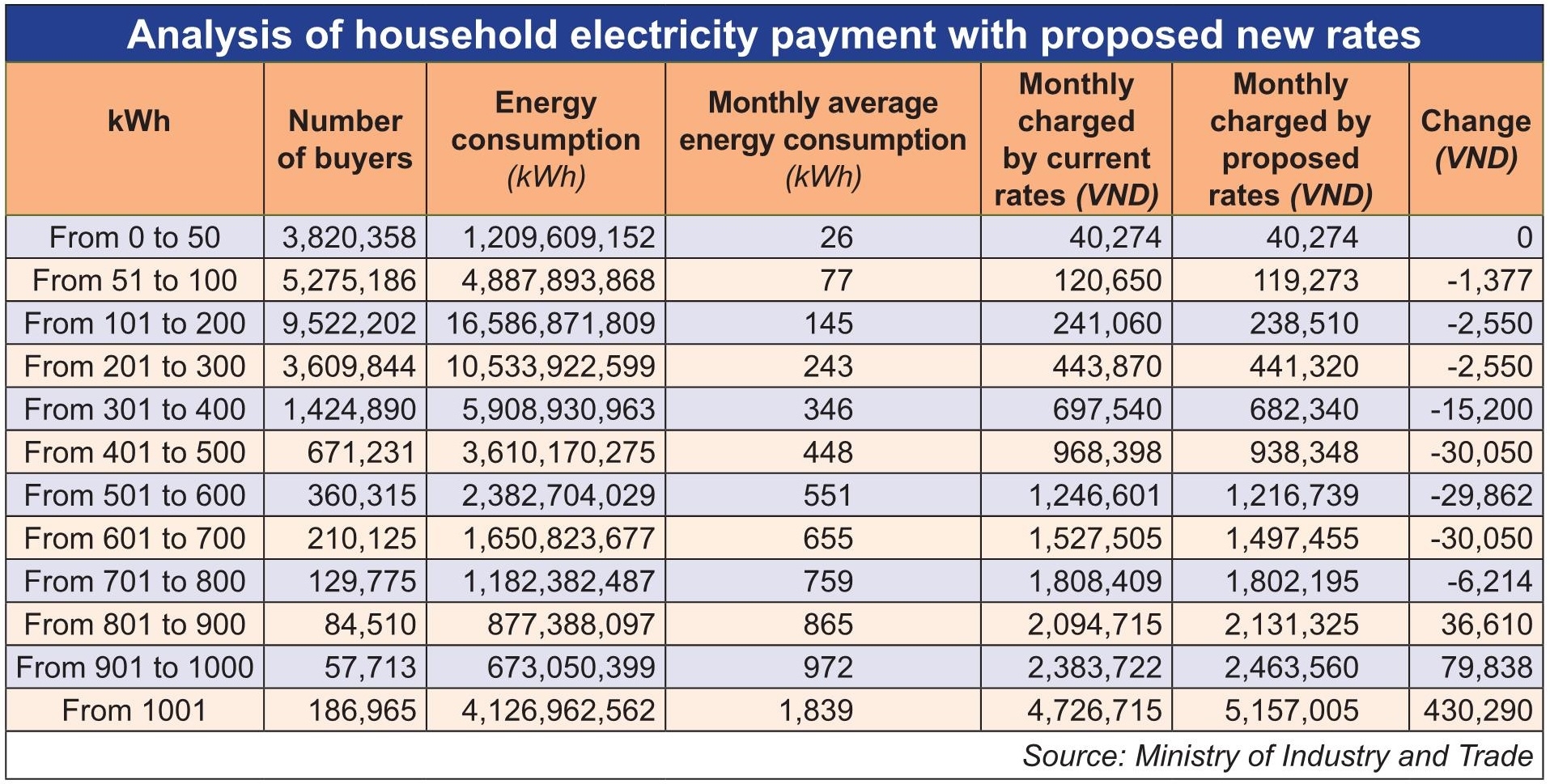New home rates offer saving potential
 |
| Energy efficiency expert Mai Van Trung |
The Ministry of Industry and Trade (MoIT) has proposed new residential rates with one level less than the current rate structure, at five levels as opposed to six.
The new structure combines levels one and two of the current structure to reflect economic growth, and that residential areas are using more electricity than before. It also increases the threshold of the final highest-charged level to the 701st kWh instead of the 401st kWh.
The MoIT claims to maintain the subsidisation for first-level electricity buyers and encourage the new level-5 buyers to adopt energy efficiency solutions. It is noted that the ministry is using data of residential users in 2018 to calculate the impacts which might result in misleading calculations, and it is unknown why the available 2019 statistics have not been sued. The proposal is a very large-scale optimisation problem including roughly 25 million residents and their losses and benefits within each scenario.
 |
The constrained optimisation can be carried out with big data over the 25 million vectors to come up with totally new rates instead of moving up the current rates.
In addition, the loss and benefit analysis of Electricity of Vietnam (EVN) for different propositions is based on the assumption of uniform distribution of energy buyers in each level, which seems to be unrealistic.
It is expected that there will be no impact for those who currently use less than or equal to 50kWh per month. Residents purchasing less than 800kWh per month can enjoy lower charges than before.
If your houses are using more than 800kWh per month, it is time to think of energy savings, particularly in houses that are consuming more than 1000kWh per month.
In general, the proposed rates structure might not have a significant impact for the revenue of EVN. However, the distribution of electricity buyers might change in 2020 and the numbers of buyers in high levels are higher than before, which can compensate for losses.
The current highest average selling prices of EVN to houses using more than 1,000kWh per month is estimated to be VND2,500 (10 US cents) per kWh which are lower than peak rates of commercials (around VND4,250-4,590 or 18-20 US cents per kWh) and industrials (around VND2,760-3,080 or 12-13 US cents per kWh).
The peak rates of commercials and industrials are from 5pm-8pm, the time that households often consume most electricity. However, if we look at the average selling price of EVN for households in 2018, it was nearly VND2,090 (9 US cents) per kWh, 25 per cent higher than industrial rates. Therefore, it is not easy to claim that EVN is subsidising industries by charging households.
In fact, the proposed rates maintain the current momentum of households to adopt energy-saving solutions such as solar rooftops and solar hot water. There are two drivers to shorten the payback time – lower investment cost and high electricity rates. A typical solar rooftop system of 3kWp costs about VND60 million ($2,608), equal to 15 per cent lower than two years ago, which can bring about a yield of 22 per cent per year (deposit interest rate is presently 6-7 per cent).
In addition, you can pay VND10 million ($435) for a solar hot water system of 300 litres per day, that will pay off within two years to compensate for the proposed highest rate of VND3,105 per kWh.
What the stars mean:
★ Poor ★ ★ Promising ★★★ Good ★★★★ Very good ★★★★★ Exceptional
Related Contents
Latest News
More News
- Businesses ramp up production as year-end orders surge (December 30, 2025 | 10:05)
- Vietjet chairwoman awarded Labour Hero title (December 29, 2025 | 13:06)
- How to unlock ESG value through green innovation (December 29, 2025 | 10:03)
- AI reshapes media and advertising industry (December 29, 2025 | 08:33)
- FPT and GELEX sign deal to develop blockchain tech for global markets (December 29, 2025 | 08:29)
- Vietnam’s GDP forecast to grow by 9 per cent in 2026 (December 29, 2025 | 08:29)
- Women entrepreneurs are key to Vietnam’s economic growth (December 29, 2025 | 08:00)
- Vietnam's top 500 value-creating enterprises announced (December 27, 2025 | 08:00)
- The PAN Group shaping a better future with ESG strategy (December 26, 2025 | 09:00)
- Masan Consumer officially lists on HSX, marking the next phase of value creation (December 25, 2025 | 13:20)

 Tag:
Tag:


















 Mobile Version
Mobile Version